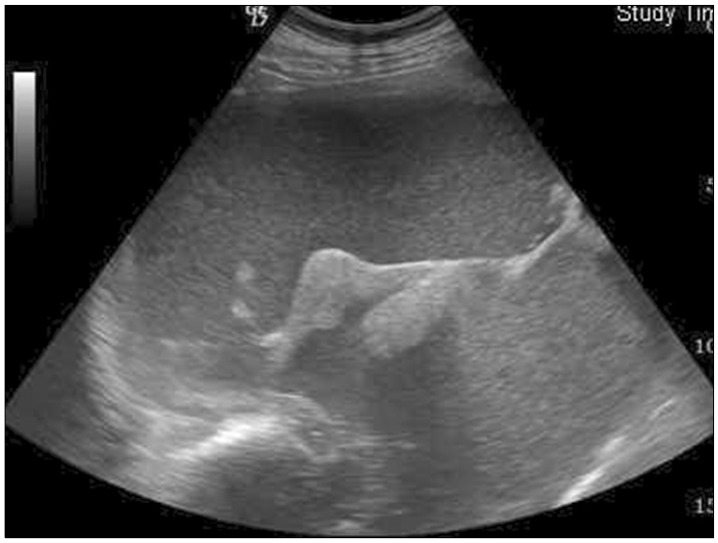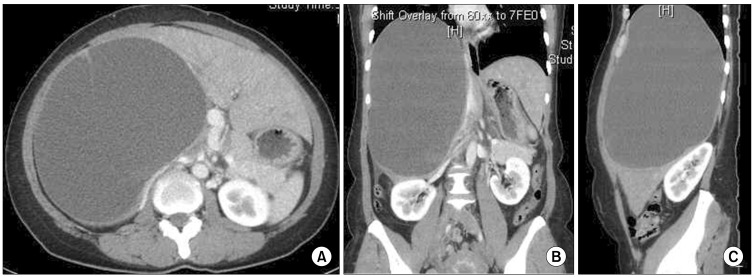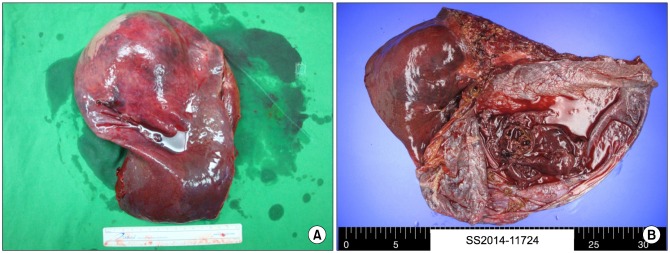Korean J Hepatobiliary Pancreat Surg.
2016 May;20(2):71-74. 10.14701/kjhbps.2016.20.2.71.
Case report of solitary giant hepatic lymphangioma
- Affiliations
-
- 1Department of Surgery, Gimpo Woori Hospital, Gimpo, Korea.
- 2Department of Radiology, Gimpo Woori Hospital, Gimpo, Korea. corbrain@naver.com
- KMID: 2243018
- DOI: http://doi.org/10.14701/kjhbps.2016.20.2.71
Abstract
- A hepatic lymphangioma is a rare benign neoplasm that is usually associated with systemic lymphangiomatosis. A solitary hepatic lymphangioma is extremely rare. Therefore, we present a rare case of a female patient who underwent right hepatectomy for solitary giant hepatic lymphangioma. A 42-year-old female presented to the emergency department with complaint of severe abdominal pain of the right upper quadrant. Abdominal computed tomography showed an approximately 23×30-cm sized, giant, relatively well-defined, homogenous cystic mass with few septa in the right liver (segments VII and VIII). The preoperative diagnosis was a giant hepatic cystadenoma or cystadenocarcinoma. We performed right hepatectomy. The permanent histopathological report revealed cystic lymphangioma of the liver. Although the prognosis of solitary hepatic lymphangioma after surgical resection is favorable, recurrence has been reported in literature.
Keyword
MeSH Terms
Figure
Reference
-
1. Stavropoulos M, Vagianos C, Scopa CD, Dragotis C, Androulakis J. Solitary hepatic lymphangioma. A rare benign tumour: a case report. HPB Surg. 1994; 8:33–36. PMID: 7993862.2. Huang L, Li J, Zhou F, Yan J, Liu C, Zhou AY, et al. Giant cystic lymphangioma of the liver. Hepatol Int. 2010; 4:784–787. PMID: 21286352.
Article3. Zhang YZ, Ye YS, Tian L, Li W. Rare case of a solitary huge hepatic cystic lymphangioma. World J Clin Cases. 2013; 1:152–154. PMID: 24303489.
Article4. Liu Q, Sui CJ, Li BS, Gao A, Lu JY, Yang JM. Solitary hepatic lymphangioma: a one-case report. Springerplus. 2014; 3:314. PMID: 25279280.
Article5. Chung JH, Suh YL, Park IA, Jang JJ, Chi JG, Kim YI, et al. A pathologic study of abdominal lymphangiomas. J Korean Med Sci. 1999; 14:257–262. PMID: 10402167.
Article6. Roisman I, Manny J, Fields S, Shiloni E. Intra-abdominal lymphangioma. Br J Surg. 1989; 76:485–489. PMID: 2660949.
Article7. Vargas-Serrano B, Alegre-Bernal N, Cortina-Moreno B, Rodriguez-Romero R, Sanchez-Ortega F. Abdominal cystic lymphangiomas: US and CT findings. Eur J Radiol. 1995; 19:183–187. PMID: 7601168.
Article





